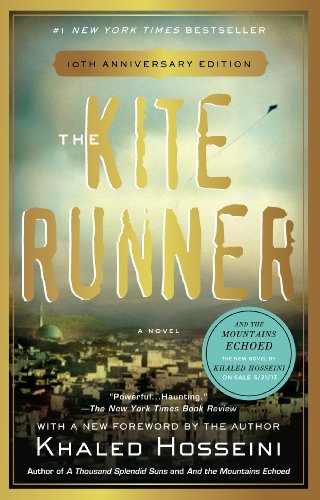All Nonfiction
- Bullying
- Books
- Academic
- Author Interviews
- Celebrity interviews
- College Articles
- College Essays
- Educator of the Year
- Heroes
- Interviews
- Memoir
- Personal Experience
- Sports
- Travel & Culture
All Opinions
- Bullying
- Current Events / Politics
- Discrimination
- Drugs / Alcohol / Smoking
- Entertainment / Celebrities
- Environment
- Love / Relationships
- Movies / Music / TV
- Pop Culture / Trends
- School / College
- Social Issues / Civics
- Spirituality / Religion
- Sports / Hobbies
All Hot Topics
- Bullying
- Community Service
- Environment
- Health
- Letters to the Editor
- Pride & Prejudice
- What Matters
- Back
Summer Guide
- Program Links
- Program Reviews
- Back
College Guide
- College Links
- College Reviews
- College Essays
- College Articles
- Back
The Kite Runner by Khaled Hosseini
Recently, I decided to read The Kite Runner by Khaled Hosseini, a novel I had heard of as “profoundly disturbing”. Before I knew it, I was turning the last page of one of the most edifying and beautiful novels I have ever read.
Set in Afghanistan in the late twentieth century, The Kite Runner vividly depicts the childhood of Amir and Hassan. Amir is a privileged Pashtun boy, while his best friend and servant, Hassan, is a Hazara destined to serve the upper class. At first, their days are filled with storytelling, trips to the market, and kite fighting, a favorite Afghan pastime, while Amir forever strives to secure the love and approval of his father, Baba. Soon, however, an act of violence and cowardice defines their lives forever, transforming Amir’s story into one of guilt and redemption.
The characters’ lives are irreparably shaped by the tumult that shakes their nation: the Soviet invasion, the exodus of Afghan refugees, and the rise of the Taliban. When the Soviets invade in 1980, Amir and Baba flee the country and journey to America to start a new life. They find themselves surrounded by other Afghan immigrants, men and women who left Afghanistan wealthy and came to America with nothing. Years later, now an adult, Amir must return to his homeland, for “there is a way to be good again.” By the time you turn the last page of The Kite Runner, the story of Amir and Hassan has come full circle. A story that began with a lost smile has ended with another smile, one that has started faintly but that will grow into something beautiful.
Reading The Kite Runner opened my eyes to the horrors that have taken place in Afghanistan over the last few decades. I was shocked and deeply disturbed to realize that such cruelty exists in our world and that such things are happening today, on our watch. Incredible violence and brutality, including ethnic cleansings, rape, murder, and stonings, are weaved into the very fabric of the characters’ lives in The Kite Runner. While the characters are fictional, what happens to them is not. Similar people are experiencing these horrors as we speak. How can we live in a world where orphan children are raped, or innocent women stoned at soccer games? How can we live in a world where these things happen? You will be forced to confront these questions, and many more, after reading The Kite Runner.
Amidst this historical backdrop are questions of guilt and redemption, courage and cowardice, friendship and betrayal. The relationship between father and son, with both its love and its tension, forms the basis of the plot, irreparably defining Amir’s character. The persistence of memory haunts the characters, and the definitions of courage, love, and friendship, are all called into question. Can the past ever truly be forgotten? Can a friendship exist when one person believes himself to be better than the other? Is cowardice the ultimate act of selfishness? Can love and friendship transcend ethnic boundaries?
The Kite Runner is filled with culture as well as history. Vibrant images of the streets in Kabul, with the savory aroma of kebabs in the air, and detailed descriptions of the lively kite-fighting festivals paint a vivid picture of life in Afghanistan – the way life could be without the violence. In California, Afghan emigrants struggle to stay true to their culture. Every Sunday, Amir and his father join the other Afghans at the flea market, selling what they have gleaned at garage sales on Saturday. The Afghan customs, such as the meticulous way Amir must court his wife before marrying her, are still held dear in America. They cling to their traditions in an attempt to preserve their cultural identity, yet still they lose much of their pride. Baba, a wealthy Afghan businessman, takes a job as a gas station manager in California. The image of General Taheri, Amir’s father-in-law, wearing his pressed grey suit and pocket watch, waiting for his chance to serve Afghanistan again, exemplifies the loss of identity and nationality that many refugees have felt as they fled their homeland to seek safety. In this struggle, war shows its other, equally destructive side – one that destroys an entire culture’s pride.
Reading The Kite Runner is a transformative experience, one that takes the reader into a torn people’s history, culture, and lifestyle. Khaled Hosseini reaches a level of literary excellence that so captivates readers that they both can’t put down his masterpiece until they are finished reading and, when they are finished, want to read more about the cultural and historical tragedy that continues to this day. The Kite Runner is, in my opinion, one of the most enlightening novels of the twenty-first century, a literary classic for the ages, and a must-read for any avid reader.
Similar Articles
JOIN THE DISCUSSION
This article has 0 comments.

